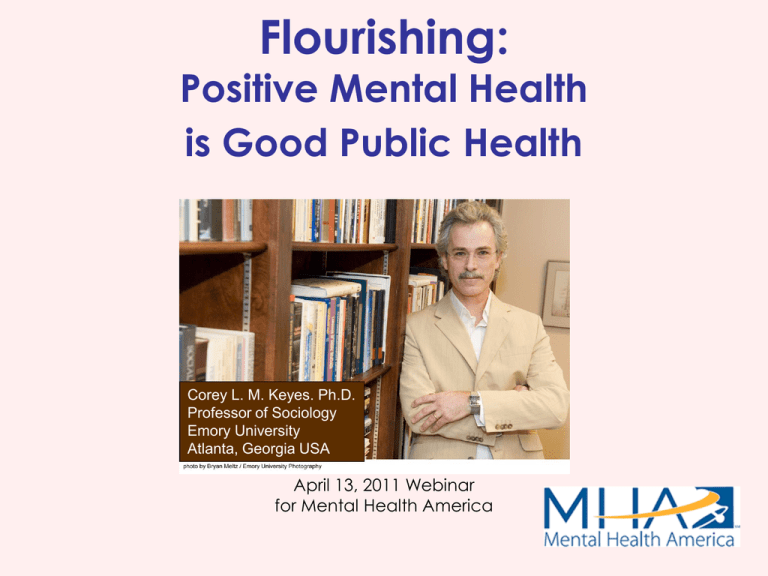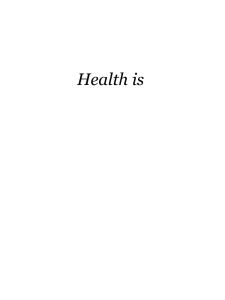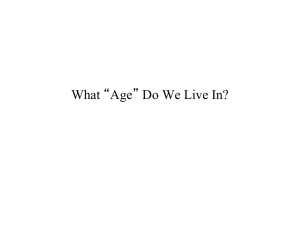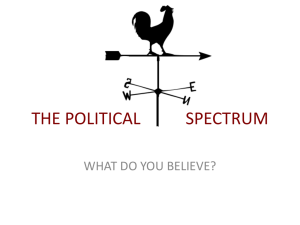
Flourishing:
Positive Mental Health
is Good Public Health
Corey L. M. Keyes. Ph.D.
Professor of Sociology
Emory University
Atlanta, Georgia USA
April 13, 2011 Webinar
for Mental Health America
The Debate
Insel and Scolnick
2006
• “All current medical treatments for
mental illnesses are palliative, none
are even proposed as cures.”
George Albee
2006
• “Public health teaches us that no
mass disease or disorder has ever
been controlled or eliminated
through individual treatment”
Family Tree of Mental Health
Positive Functioning
I
Me
Positive Feeling
We Us
Psychological Well-Being
Social Well-Being
Emotional Well-Being
Self-Acceptance
Social Acceptance
Happiness
Positive Relations with Others
Social Integration
Satisfaction
Personal Growth
Social Growth
Purpose in Life
Social Contribution
Environmental Mastery
Social Coherence
Autonomy
Interest in Life
Structure of Well-Being
Psychological Well-Being
Social Well-Being
Emotional Well-Being
Self-Acceptance
Social Coherence
Positive Affect
Positive Relations
Social Actualization
Avowed Quality of Life
Personal Growth
Social Integration
Purpose in Life
Social Acceptance
Environmental Mastery
Social Contribution
Autonomy
Mental Health Continuum
• Flourishing
“almost every day” or “every day”
1 emotional well-being + 6 positive functioning
•
Moderate
•
Languishing
“never” or “once or twice”
1 emotional well-being + 6 positive functioning
The Two Continua Model
©2010 CLM Keyes and the Winnipeg Regional Health Authority
High HDL
Low LDL
High LDL
Low HDL
Keyes and Kendler papers
(AJPH 2010)
A2
E2
A2M
• Best fit model
E2M
Positive
Mental Health
– Common Factor Model (AE)
• 72% heritable
– Sex equality
MWBE
MWBS
MWBP
EWB
1995
SWB
1995
PWB
1995
A6
E6
A7
E7
A8
E8
A6
E6
A7
E7
A8
E8
Keyes and Kendler papers
(Behavior Genetics, In press)
A1
E1
A1I
A2
E1I
A1M
Internalizing
Psychopathology
E1M
E2
A2M
E2M
Positive
Mental Health
IDM
IDG
IDP
MWBE
MWBS
MWBP
MDE
1995
GAD
1995
Panic
1995
EWB
1995
SWB
1995
PWB
1995
A3
E3
A4
E4
A5
E5
A6
E6
A7
E7
A8
E8
A3
E3
A4
E4
A5
E5
A6
E6
A7
E7
A8
E8
Implication 1:
Absence MI ≠ Presence MH
Implication 1
U.S. Adolescent Population Ages 12-18 (2002; n= 1,290)
90
85
80
75
70
65
60
55
50
45
40
35
30
25
20
15
10
5
0
85.7
14.3
Screens for Depression
Free of Depression
Implication 1
U.S. Adolescent Population Ages 12-18 (2002; n= 1,290)
90
85
80
75
70
65
60
55
50
45
40
35
30
25
20
15
10
5
0
37
Flourishing
Moderate
Languishing
46.2
1.9
9.7
2.7
Screens for Depression
2.5
Free of Depression
Implication 1
US College Students (2007; n = 5,750)
90
85
80
75
70
65
60
55
50
45
40
35
30
25
20
15
10
5
0
74.5
25.5
Screens Positive on PHQ
Free of Mental Illness
Implication 1
US College Students (2007; n = 5,750)
90
85
80
75
70
65
60
55
50
45
40
35
30
25
20
15
10
5
0
Flourishing
Moderate
Languishing
46
5.8
27.6
16.9
2.8
Screens Positive on PHQ
0.8
Free of Mental Illness
Implication 2:
Level of Mental Health Matters
Implication 2
(Keyes et al, in press)
40
% Reporting Suicidality
35
30
Free of PHQ Diagnoses
25
20
15.4
15
10
3.9
5
1.3
0
Languishing
Moderate
Mental Health (Categorical Diagnosis)
Flourishing
Implication 2
(Keyes et al, in press)
40
% Reporting Suicidality
35
30
Screened Positive on PHQ
28.3
Free of PHQ Diagnoses
25
20
18.1
15.4
15
10
7.0
3.9
5
1.3
0
Languishing
Moderate
Mental Health (Categorical Diagnosis)
Flourishing
Summary of Research “Level of MH Matters”:
Anything Less Than Flourishing
In Adults
1.
2.
3.
4.
5.
Chronic Physical Illness with Age (Keyes, 2005b)
Cardiovascular Disease (Keyes, 2004a)
Disability (Keyes, 2002)
Productivity Losses (Keyes, 2002, 2007; Keyes & Grzywacz, 2005)
Healthcare Use (Keyes & Grzywacz, 2005)
– Overnight Hospitalizations
– Medical Visits
• for Physical Health Reasons
• for Mental-Emotional Reasons
– Prescription Medications
Summary of Research “Level of MH Matters”:
Anything Less Than Flourishing
Adolescents and College Students
1.
2.
3.
4.
5.
6.
7.
8.
Suicidal Behaviors (Keyes et al in press)
Conduct Problems (Keyes, 2006)
Poor academic performance (Howell, 2009)
Fixed vs. Growth Mindset (Howell, 2009)
Outcome vs. Mastery Goals (Howell, 2009)
Procrastination (Howell, 2009)
Curiosity (exploration) (Gallagher & Lopez, 2007)
Personal Growth Initiative (Robitschek & Keyes, 2009)
Implication 3:
Absence of MH ≈ Presence of MI
Implication 3
Absence of Positive
40
% Reporting Suicidality
35
30
Screened Positive for a
Mental Illness
28.3
No Mental Illness
25
20
18.1
15.4
15
10
7.0
3.9
5
1.3
0
Languishing
Moderate
Mental Health (Categorical Diagnosis)
Flourishing
Implication 3
Absence of Positive
40
% Reporting Suicidality
35
30
Screened Positive for a
Mental Illness
28.3
No Mental Illness
25
20
18.1
15.4
15
10
7.0
3.9
5
1.3
0
Languishing
Moderate
Mental Health (Categorical Diagnosis)
Flourishing
Implication 4:
Health Is More Serious
Change in Flourishing
1995
Flourishing
19.2%
2005
50.6%
22.3%
Flourishing
46.3%
3.1%
Moderate
Mental Health
Languishing
63.6%
17.2%
60.4%
17.3%
Moderate
Mental Health
Languishing
Change in Moderate Mental Health
1995
Flourishing
2005
19.2%
22.3%
Flourishing
18.6%
Moderate
Mental Health
63.6%
67.5%
60.4%
Moderate
Mental Health
13.9%
Languishing
17.2%
17.3%
Languishing
Change in Languishing
1995
Flourishing
Moderate
Mental Health
2005
19.2%
22.3%
63.6%
60.4%
Flourishing
Moderate
Mental Health
4.1%
50.2%
Languishing
17.2%
45.7%
17.3%
Languishing
Implication 4: Health Is More Serious
10
9
8.2
8
7
6.6
6
5
4.4
4
3.7
3.4
3
2
1
1
1
Improved to
Flourishing
Stayed
Flourishing
0
Stayed
Languishing
Declined to
Languishing
Improved to
Moderate
Stayed Moderate
Declined to
Moderate
17.5% Any Mental illness in 2005 (52% incidence)
10
9
3.9%
+
35.5%
+
6.5%
8.2
8
+
4.8%
7
7.8%
=
10.4%
=
48.1%
=
58.5%
6.5%
6.6
6
3.9%
5
5
4.4
4
18.5%
3.7
3.4
35.5%
3
7.8%
4.7%
2
1
1
1
Improved to
Flourishing
Stayed
Flourishing
0
Stayed
Languishing
Declined to
Languishing
Improved to
Moderate
Stayed
Moderate
Declined to
Moderate
Any Mental
Illness 1995
Can We Promote It?
How can we promote positive mental health?
Moving from a risk reduction model to a
competence enhancement model
ACT and Mindfulness
Psychological flexibility
acceptance of experiences
value-based behavior
08/04/2015
33
Intervention “Living to the full”
Combination of ACT and mindfulness
8 weekly sessions of 2 hours in groups with 8 persons with two therapists
93 participants with mild to moderate psychological distress
49 participants received “Living to the full”
44 participants on the waiting list
Measurements before, after the intervention and 3-months follow-up
Positive Mental Health: Mental Health Continuum-Short Form (MHC-SF)
Psychological Flexibility: Acceptance and Action Questionnaire-II (AAQ-II)
08/04/2015
34
Results: Positive mental health
Effect size = .85
Positive Mental Health (MHC-SF)
3.9
3.7
3.5
3.3
3.1
ACT & mindfulness intervention
2.9
Waiting list
2.7
2.5
Before
After
Follow-up
08/04/2015
Results: Psychological flexibility
Effect size = .74
Psychological Flexibility (AAQ-II)
48
46
44
42
40
38
36
ACT & mindfulness intervention
34
Waiting list
32
Before
After
Follow-up
08/04/2015
Results
Psychological flexibility mediates effect of intervention
Intervention
Better
positive mental health
Improved
Psychogical Flexibility
08/04/2015
Yes we can
Promoting mental health
By stimulating skills for acceptance
By sharpening skills for responding based on own values
“Living to the full” implemented in almost 50% of the mental health
institutions in the Netherlands
08/04/2015
38
What Society Gains
When More People Flourish
• Reduced Mental Illness
• Reduced Suicidality
– Reduced Premature Mortality
• Better Functioning
Towards a Flourishing America
Yes we can












